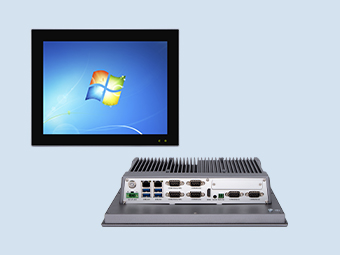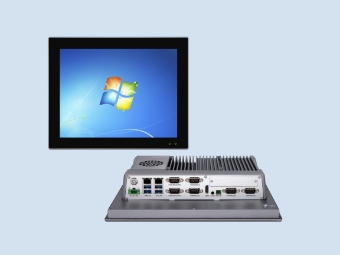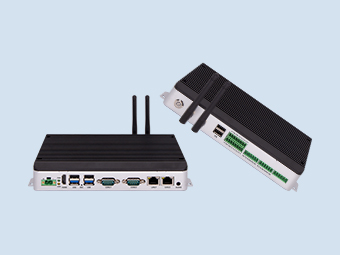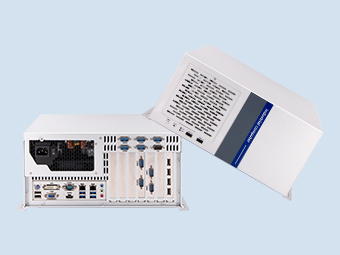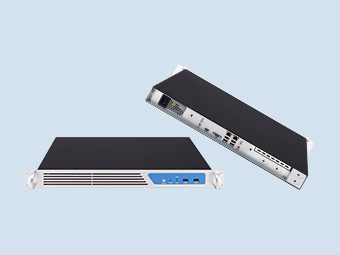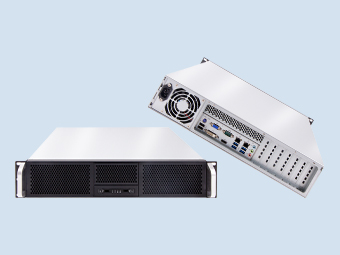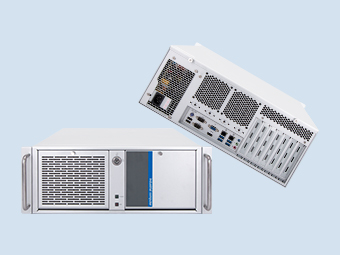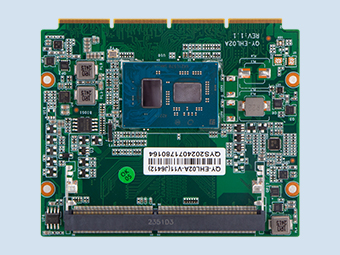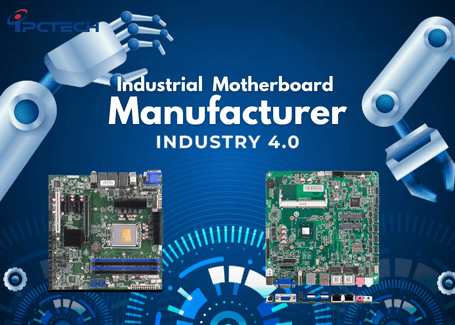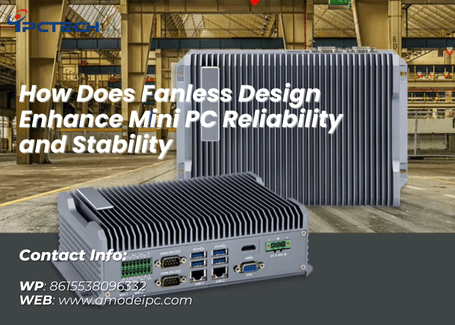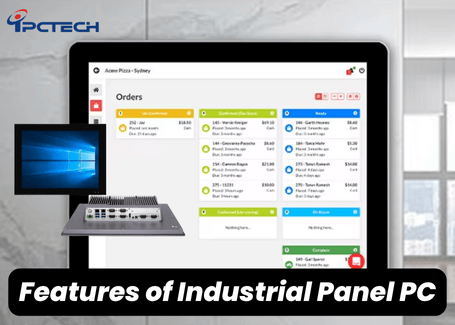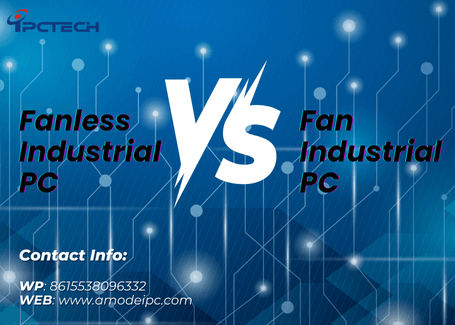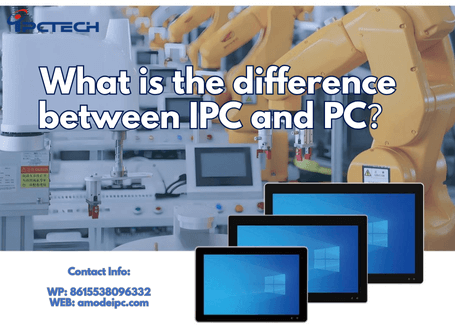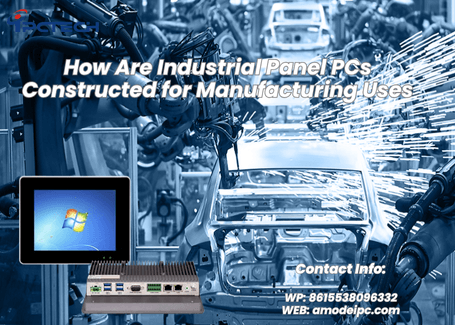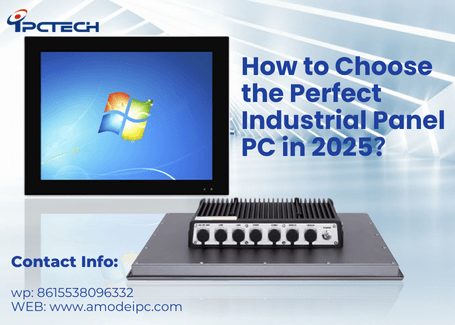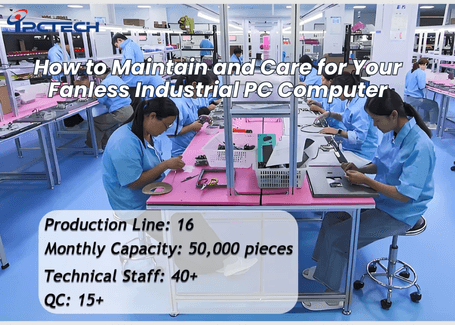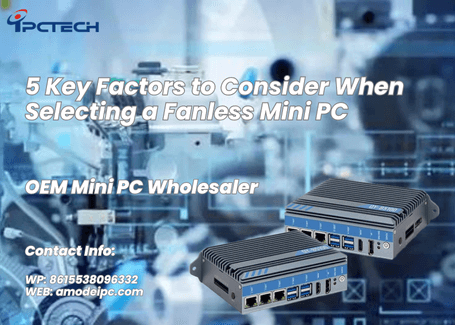6 Common Mistakes When Selecting a Fanless Industrial Panel PC
2025-09-22
In dust-filled production workshops, beside machinery with frequent vibrations, or in outdoor environments with extreme temperature fluctuations, fanless industrial panel PCs with their fanless cooling design, have become core devices for industrial automation, IoT, and surveillance systems. Unlike standard consumer-grade touchscreens, these systems must deliver 24/7 stable operation in harsh environments. Incorrect selection not only leads to frequent equipment failures but can also cause production line shutdowns.
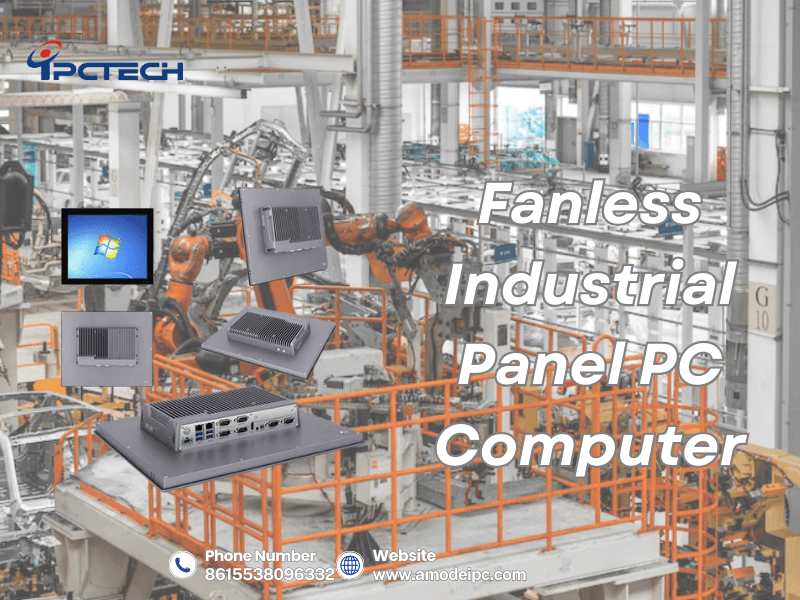
Fanless industrial panel PCs rely on passive cooling designs, where heat is dissipated through metal casings and heat sinks into the surrounding air. This means their operational status is highly dependent on environmental conditions. Neglecting environmental compatibility can lead to minor issues like system freezes and lag, or severe consequences such as motherboard burnout.
Many companies use consumer-grade panel PCs (like standard commercial touchscreens) in industrial settings to cut costs. For example, an automotive parts factory installed household-grade tablets in a welding workshop. Due to high dust concentration and temperatures frequently reaching 45°C, the devices experienced touchscreen malfunctions and internal component short circuits within just three months. Consumer-grade equipment typically has an IP20 dust protection rating, unable to prevent dust ingress, and an operating temperature range of only 0-35°C—far below industrial requirements.
1. Prioritize confirming the device's operating temperature range. Industrial-grade products must support wide-temperature operation from -20°C to 60°C. For extreme cold environments (e.g., cold chain warehouses), select specialized models rated for -30°C to 55°C.
2. Dust and water resistance must meet IP65 or higher. Front-facing protection (screen side) should be upgraded to IP67 to prevent damage from liquid splashes or high-pressure water jet cleaning.
3. In high-humidity environments (e.g., food processing plants, aquaculture facilities), additionally verify the device's humidity tolerance range (typically requiring 10%–90% RH without condensation) and select enclosures with anti-corrosion coatings.
Fanless designs are constrained by passive cooling capabilities, typically requiring low-power processors. Blindly pursuing high performance or excessively compromising on specs compromises both device usability and cost control.
• Performance Overkill: An electronics factory selected a fanless tablet with an Intel Core i7 processor for production line monitoring, yet it only ran a basic HMI (Human-Machine Interface) system. This not only increased procurement costs by 30%, but the processor's high power consumption (15W) caused localized overheating during summer, necessitating additional cooling brackets.
1. Match CPU to application scenarios:
- For basic HMI or data acquisition: Intel Celeron N5105 (4W TDP) For scenarios requiring lightweight IoT platforms or simple algorithms, consider the Intel Core i3-1215U (10W TDP); For complex machine vision or edge computing scenarios, consider the Intel Core i5-1235U (15W TDP), but verify the device's thermal design compatibility;
2. Pay attention to the processor's TDP (Thermal Design Power). For fanless devices, select models with TDP ≤ 15W to avoid performance throttling due to thermal constraints.
3. If running multitasking or legacy software, simultaneously verify memory capacity (minimum 8GB DDR4) and storage type (industrial-grade eMMC or SSD; avoid consumer-grade HDD to prevent data corruption from vibration).
Industrial power grids frequently experience voltage fluctuations due to the start-up and shutdown of large equipment (e.g., sudden drops from 12V DC to 9V, or surges from 24V to 28V). Fanless tablets lack independent power protection modules, and improper power supply adaptation can easily lead to motherboard component burnout or data loss.
• A chemical plant used a standard commercial power adapter (12V/2A output) to power a fanless panel PC. Voltage drops triggered by large workshop pumps caused frequent reboots, resulting in three instances of critical production data loss within one month.
1. Select devices supporting wide voltage input. Industrial-grade fanless tablets should accommodate 12V–24V DC input, with some high-end models supporting 9V–36V DC to adapt to diverse industrial power grid environments;
2. Critical systems (e.g., emergency monitoring, safety alarms) require redundant power supplies. Implement dual power modules with hot standby capability. Upon primary power failure, the backup power supply must switch within 100ms to ensure uninterrupted operation.
3. Install additional surge protection devices (SPDs) to prevent equipment damage from lightning strikes or voltage spikes. Protectors must comply with IEC 61643-11 standards and have a rated discharge current ≥5kA.
Fanless industrial tablets typically feature fixed, built-in I/O interfaces that cannot be retrofitted. Failure to adequately plan interface needs during initial design may prevent the device from connecting to sensors, PLCs (Programmable Logic Controllers), or peripherals. This necessitates purchasing additional adapter modules, increasing costs and potential failure points.
• A smart factory selected a fanless tablet with only two USB-A ports. It required connecting three devices—a barcode scanner, mouse, and data collector—forcing the use of a USB hub for expansion. This caused insufficient power delivery, resulting in frequent disconnections of the barcode scanner.
• A warehouse logistics project overlooked PoE (Power over Ethernet) requirements, necessitating separate power cabling for tablets. This duplicated Ethernet cabling, increasing construction costs by 50%.
1. Pre-list all devices requiring connection, specifying interface types and quantities:
◦ Industrial Communication: At least 1 RS-485 port (for PLC/sensor connections), 2 Gigabit Ethernet ports (1 for data transmission, 1 spare);
◦ Peripheral Connectivity: At least 2 USB-A 3.0 ports (supporting fast charging), 1 USB-C port (for both data transfer and power delivery);
◦ Display Expansion: 1 HDMI 2.0 port (for external monitors);
Reserve Expansion Ports: Select models with mini-PCIe slots to enable future upgrades with 4G/5G modules, Wi-Fi 6 modules, or GPS modules for evolving application requirements.
The heat dissipation capability of industrial panel PCs computer directly determines equipment stability. Defective heat dissipation design—such as insufficient heat sink area or poor thermal conductivity of the enclosure material—can lead to heat buildup, shorten component lifespan, and even cause sudden failures.
• A company selected a fanless tablet with a plastic enclosure, featuring only a small internal aluminum heat sink. During summer operation, the enclosure temperature reached 55°C, causing frequent processor throttling and extending data acquisition intervals from 1 second to 3 seconds.
• A device integrator installed a fanless tablet inside a sealed control cabinet without allowing ventilation space. The cabinet temperature rose to 60°C, causing three consecutive motherboard burnout failures.
◦ Enclosure material: Prioritize aluminum alloy with thermal conductivity ≥100 W/(m·K); avoid plastic enclosures.
◦ Heat sinks: Verify heat sink area (covering at least 30% of the enclosure's internal surface) and material. Copper heat sinks (thermal conductivity 401 W/(m・K)) outperform aluminum (237 W/(m・K)). Ensure heat sinks are tightly bonded to processors and chipsets.
Allow ventilation space during installation: Maintain ≥5cm clearance around equipment inside control cabinets, or install dedicated cabinet cooling fans to ensure internal temperatures do not exceed the device's maximum operating temperature.
Industrial settings often require specialized software (such as SCADA systems, MES systems) or legacy programs. If the operating system of a fanless tablet is incompatible, it can prevent software installation or cause abnormal operation, disrupting business processes.
• A textile factory selected fanless tablets pre-installed with Windows 11 Home to run legacy MES software that only supported Windows 7. After attempting compatibility mode, the software frequently crashed, preventing production data logging.
• An IoT project failed to verify system support for the MQTT protocol, causing tablets to fail data exchange with sensors. Additional driver development was required, delaying project launch by two weeks.
1. Prioritize devices pre-installed with industrial-grade operating systems, such as Windows 11 IoT Enterprise or Linux;
2. When running legacy software, verify if the device supports downgrading the OS and ensure the manufacturer provides corresponding drivers (especially for touchscreens and network cards);
3. For IoT scenarios, confirm system support for industrial protocols to avoid developing additional protocol conversion modules later.
To streamline the selection process, the following 5-step checklist helps businesses quickly mitigate risks:
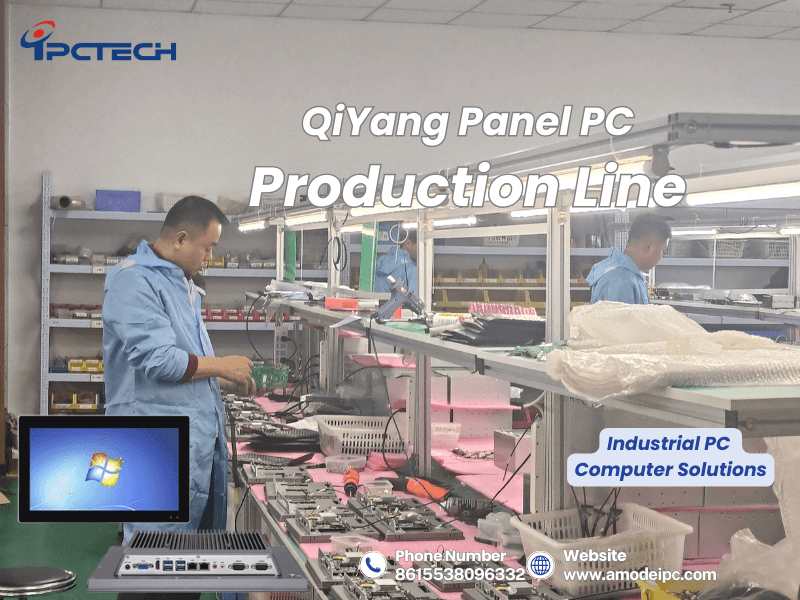
Selecting an industrial panel computer fundamentally involves “aligning application requirements with device capabilities.” In the use of industrial fanless panel PCs, environmental compatibility, thermal design, and long-term supply stability are the core issues most likely to cause significant losses. Neglecting environmental compatibility directly shortens device lifespan, thermal deficiencies trigger sudden failures, and supply disruptions impact production line continuity.
We've established a comprehensive industrial computing product matrix encompassing fanless industrial panel PCs, industrial all-in-one PCs, industrial motherboards, industrial mini PCs, vehicle mount panel PCs, and more. With sizes ranging from 7 to 32 inches, our solutions address everything from basic human-machine interaction to complex edge computing, and from fixed workstations to mobile vehicle-mounted scenarios. This enables one-stop matching for diverse industry needs—including smart manufacturing, intelligent logistics, outdoor surveillance, and medical equipment—eliminating the need for cross-brand procurement and integration.
All products adhere to industrial-grade design standards. Fanless industrial tablets and all-in-ones achieve IP65 dust and water resistance, with front panels supporting IP67 short-term immersion protection. They withstand workshop dust, high-pressure water jet cleaning, and liquid splashes. Housed in monolithic aluminum alloy or stainless steel enclosures, select models offer optional anti-corrosion coatings for chemical, aquaculture, and food processing environments. Durability exceeds standard industrial products by over 30%.
Addressing industrial temperature fluctuation challenges, IPCTECH products default to a -10°C to 60°C operating range. Through component screening and optimized thermal design, they ensure 24/7 stable operation in high-temperature workshops and cold outdoor environments. Custom low-temperature models are also available, supporting extreme conditions from -30°C to 55°C. This meets specialized requirements for cold chain storage and northern winter outdoor applications, preventing temperature-induced system crashes or component damage.
Equipped with Intel's full spectrum of low-power processors, ranging from entry-level Celeron N series (TDP 4W, suitable for basic HMI) and mid-performance Pentium series (TDP 10W, suitable for lightweight IoT data processing) to high-performance Core i3/i5 series (TDP 15W, suitable for machine vision and edge computing). All configurations include industrial-grade DDR4 memory (8-32GB) and SSD/eMMC storage (128GB-2TB). While ensuring computational power, the efficient passive cooling design enables fanless, silent operation, reducing power consumption by 15% compared to similar products.
AMODE IPC industrial products come standard with multiple industrial interfaces, including 2-4 Gigabit Ethernet ports (supporting PoE+ power delivery), 1-2 RS-485/RS-232 serial ports (Modbus protocol compatible), USB-A 3.0/USB-C ports, and HDMI 2.0 display interfaces. This enables direct connectivity to PLCs, sensors, barcode scanners, industrial cameras, and other devices. Select models feature a reserved mini-PCIe slot supporting 4G/5G, Wi-Fi 6, and GPS module expansion to meet IoT wireless communication and mobile application requirements.
The dedicated Vehicle Mount Panel PC series is optimized for automotive environments, passing ISO 16750 automotive electronics testing. It delivers vibration resistance (10-500Hz, 5G acceleration) and shock resistance (50G peak), making it suitable for mobile equipment like forklifts, AGVs, and freight vehicles. Supports 12-36VDC wide voltage input to accommodate vehicle power fluctuations, while featuring a high-brightness display (≥1000 nits) to eliminate screen glare in outdoor vehicle environments.
Supports Windows 11 IoT Enterprise, Linux, Android 11, and other systems. The Windows version offers extended support, ensuring compatibility with legacy industrial software and direct integration with SCA.
Offering multiple mounting options including embedded, wall-mounted, rack-mounted, desktop, and vehicle-mounted brackets, with support for VESA standard mounting holes. Flexibly adapts to workshop workstations, equipment cabinets, and vehicle spaces. Customization services include personalized adjustments to screen size, interface configuration, housing material, protection rating, and pre-installed systems to meet specialized requirements in medical, explosion-proof, and military applications.
IPCTECH guarantees stable supply for all products for over 5 years, eliminating replacement costs due to discontinued models. Products utilize industrial-grade components with a Mean Time Between Failures (MTBF) ≥50,000 hours, delivering a service life of 7-10 years—significantly exceeding consumer-grade products. Internal components feature soldered designs to minimize slot loosening failures, reducing maintenance frequency and costs.
IPCTECH operates 8 regional repair centers, offering a 3-year complimentary warranty (upgradable to 5 years) covering parts and labor. We provide 48-hour rapid response and spare unit services for critical scenarios to prevent production line downtime due to equipment failure. Additionally, we deliver end-to-end support including prototype trials (1-2 units, 2-4 weeks testing), on-site technical guidance, and system commissioning to accelerate customer deployment.
The rating must be determined based on the risk of dust and liquid exposure in the operating environment. Key reference scenarios and corresponding ratings are as follows:
• Dry, dust-free environments (e.g., clean zones in electronics workshops, office monitoring systems): IP65 rating is sufficient, providing protection against dust ingress and vertical liquid splashes for basic safeguarding.
• Damp and dusty environments (e.g., food processing plants, textile factories): Prioritize IP65 + front IP67 rating. Front IP67 withstands short-term immersion (up to 1 meter for 30 minutes), handling high-pressure water jet cleaning during workshop sanitation and splashes from standing water;
• Oil-contaminated environments (e.g., machining workshops, auto repair bays): Beyond IP65 protection, require additional oil-resistant coatings on the housing and screen to prevent oil buildup that could impair touch sensitivity and heat dissipation efficiency;
• Outdoor environments (e.g., solar power plants, open-air warehouses): Opt for IP66 + front IP67 rating. IP66 withstands intense water jets (like heavy rain), and combined with wide-temperature design, it adapts to complex outdoor weather conditions.
Standard fanless industrial tablets (default operating range: -20°C to 60°C) cannot directly function at -30°C. Adaptation requires:
• Select low-temperature custom models: Some manufacturers offer cold-adapted versions featuring optimized motherboard components (e.g., low-temperature capacitors/resistors) and integrated preheating modules, enabling operation from -30°C to 55°C. Suitable for cold chain warehouses, northern outdoor environments, etc.
• Temporary workaround: If device replacement is not feasible, install small constant-temperature heating devices (e.g., low-power heating pads) around the equipment. Combined with an insulated enclosure, this maintains ambient temperatures above -20°C. Ensure heating device power consumption remains ≤10W to prevent affecting power supply stability.
• Precautions: In low-temperature environments, touchscreen response may be delayed (from 0.1 seconds to 0.3 seconds). Pre-testing is required to confirm operational suitability. Avoid frequent power cycling in cold conditions to prevent component damage from thermal shock.
• Basic scenarios (e.g., HMI human-machine interaction, simple data acquisition): Prioritize low-power entry-level CPUs. These offer low power consumption and minimal thermal management requirements, sufficient for routine data display and basic command transmission while maintaining cost control.
• Moderate Scenarios (e.g., lightweight IoT platform operation, small-scale MES systems): Recommend mid-performance low-power CPUs like Intel Core i3. Their computational power sufficiently supports multi-device data aggregation and basic algorithm processing while remaining compatible with fanless passive cooling.
• Complex scenarios (e.g., machine vision inspection, edge computing): High-performance low-power CPUs like Intel Core i5 are required. However, ensure robust thermal design (e.g., copper heatsinks, large aluminum alloy casings) to prevent thermal throttling.

Error 1: Neglecting Environmental Compatibility (Temperature, Humidity, Dust)
Fanless industrial panel PCs rely on passive cooling designs, where heat is dissipated through metal casings and heat sinks into the surrounding air. This means their operational status is highly dependent on environmental conditions. Neglecting environmental compatibility can lead to minor issues like system freezes and lag, or severe consequences such as motherboard burnout.
Common Misconceptions
Many companies use consumer-grade panel PCs (like standard commercial touchscreens) in industrial settings to cut costs. For example, an automotive parts factory installed household-grade tablets in a welding workshop. Due to high dust concentration and temperatures frequently reaching 45°C, the devices experienced touchscreen malfunctions and internal component short circuits within just three months. Consumer-grade equipment typically has an IP20 dust protection rating, unable to prevent dust ingress, and an operating temperature range of only 0-35°C—far below industrial requirements.
Professional Recommendations
1. Prioritize confirming the device's operating temperature range. Industrial-grade products must support wide-temperature operation from -20°C to 60°C. For extreme cold environments (e.g., cold chain warehouses), select specialized models rated for -30°C to 55°C.
2. Dust and water resistance must meet IP65 or higher. Front-facing protection (screen side) should be upgraded to IP67 to prevent damage from liquid splashes or high-pressure water jet cleaning.
3. In high-humidity environments (e.g., food processing plants, aquaculture facilities), additionally verify the device's humidity tolerance range (typically requiring 10%–90% RH without condensation) and select enclosures with anti-corrosion coatings.
Error 2: Neglecting Processor-Performance Compatibility
Fanless designs are constrained by passive cooling capabilities, typically requiring low-power processors. Blindly pursuing high performance or excessively compromising on specs compromises both device usability and cost control.
Common Misconceptions
• Performance Overkill: An electronics factory selected a fanless tablet with an Intel Core i7 processor for production line monitoring, yet it only ran a basic HMI (Human-Machine Interface) system. This not only increased procurement costs by 30%, but the processor's high power consumption (15W) caused localized overheating during summer, necessitating additional cooling brackets.
Professional Recommendations
1. Match CPU to application scenarios:
- For basic HMI or data acquisition: Intel Celeron N5105 (4W TDP) For scenarios requiring lightweight IoT platforms or simple algorithms, consider the Intel Core i3-1215U (10W TDP); For complex machine vision or edge computing scenarios, consider the Intel Core i5-1235U (15W TDP), but verify the device's thermal design compatibility;
2. Pay attention to the processor's TDP (Thermal Design Power). For fanless devices, select models with TDP ≤ 15W to avoid performance throttling due to thermal constraints.
3. If running multitasking or legacy software, simultaneously verify memory capacity (minimum 8GB DDR4) and storage type (industrial-grade eMMC or SSD; avoid consumer-grade HDD to prevent data corruption from vibration).
Error 3: Neglecting Power Supply Stability and Redundancy Design
Industrial power grids frequently experience voltage fluctuations due to the start-up and shutdown of large equipment (e.g., sudden drops from 12V DC to 9V, or surges from 24V to 28V). Fanless tablets lack independent power protection modules, and improper power supply adaptation can easily lead to motherboard component burnout or data loss.
Common Misconceptions
• A chemical plant used a standard commercial power adapter (12V/2A output) to power a fanless panel PC. Voltage drops triggered by large workshop pumps caused frequent reboots, resulting in three instances of critical production data loss within one month.
Professional Recommendations
1. Select devices supporting wide voltage input. Industrial-grade fanless tablets should accommodate 12V–24V DC input, with some high-end models supporting 9V–36V DC to adapt to diverse industrial power grid environments;
2. Critical systems (e.g., emergency monitoring, safety alarms) require redundant power supplies. Implement dual power modules with hot standby capability. Upon primary power failure, the backup power supply must switch within 100ms to ensure uninterrupted operation.
3. Install additional surge protection devices (SPDs) to prevent equipment damage from lightning strikes or voltage spikes. Protectors must comply with IEC 61643-11 standards and have a rated discharge current ≥5kA.
Error 4: Underestimating I/O Interface and Expansion Requirements
Fanless industrial tablets typically feature fixed, built-in I/O interfaces that cannot be retrofitted. Failure to adequately plan interface needs during initial design may prevent the device from connecting to sensors, PLCs (Programmable Logic Controllers), or peripherals. This necessitates purchasing additional adapter modules, increasing costs and potential failure points.
Common Pitfalls
• A smart factory selected a fanless tablet with only two USB-A ports. It required connecting three devices—a barcode scanner, mouse, and data collector—forcing the use of a USB hub for expansion. This caused insufficient power delivery, resulting in frequent disconnections of the barcode scanner.
• A warehouse logistics project overlooked PoE (Power over Ethernet) requirements, necessitating separate power cabling for tablets. This duplicated Ethernet cabling, increasing construction costs by 50%.
Professional Recommendations
1. Pre-list all devices requiring connection, specifying interface types and quantities:
◦ Industrial Communication: At least 1 RS-485 port (for PLC/sensor connections), 2 Gigabit Ethernet ports (1 for data transmission, 1 spare);
◦ Peripheral Connectivity: At least 2 USB-A 3.0 ports (supporting fast charging), 1 USB-C port (for both data transfer and power delivery);
◦ Display Expansion: 1 HDMI 2.0 port (for external monitors);
Reserve Expansion Ports: Select models with mini-PCIe slots to enable future upgrades with 4G/5G modules, Wi-Fi 6 modules, or GPS modules for evolving application requirements.
Error 5: Neglecting Rational Heat Dissipation Design
The heat dissipation capability of industrial panel PCs computer directly determines equipment stability. Defective heat dissipation design—such as insufficient heat sink area or poor thermal conductivity of the enclosure material—can lead to heat buildup, shorten component lifespan, and even cause sudden failures.
Common Misconceptions
• A company selected a fanless tablet with a plastic enclosure, featuring only a small internal aluminum heat sink. During summer operation, the enclosure temperature reached 55°C, causing frequent processor throttling and extending data acquisition intervals from 1 second to 3 seconds.
• A device integrator installed a fanless tablet inside a sealed control cabinet without allowing ventilation space. The cabinet temperature rose to 60°C, causing three consecutive motherboard burnout failures.
Professional Recommendations
1. Verify thermal design details:
◦ Enclosure material: Prioritize aluminum alloy with thermal conductivity ≥100 W/(m·K); avoid plastic enclosures.
◦ Heat sinks: Verify heat sink area (covering at least 30% of the enclosure's internal surface) and material. Copper heat sinks (thermal conductivity 401 W/(m・K)) outperform aluminum (237 W/(m・K)). Ensure heat sinks are tightly bonded to processors and chipsets.
Allow ventilation space during installation: Maintain ≥5cm clearance around equipment inside control cabinets, or install dedicated cabinet cooling fans to ensure internal temperatures do not exceed the device's maximum operating temperature.
Error 6: Neglecting Software Compatibility with the Operating System
Industrial settings often require specialized software (such as SCADA systems, MES systems) or legacy programs. If the operating system of a fanless tablet is incompatible, it can prevent software installation or cause abnormal operation, disrupting business processes.
Common Misconceptions
• A textile factory selected fanless tablets pre-installed with Windows 11 Home to run legacy MES software that only supported Windows 7. After attempting compatibility mode, the software frequently crashed, preventing production data logging.
• An IoT project failed to verify system support for the MQTT protocol, causing tablets to fail data exchange with sensors. Additional driver development was required, delaying project launch by two weeks.
Professional Recommendations
1. Prioritize devices pre-installed with industrial-grade operating systems, such as Windows 11 IoT Enterprise or Linux;
2. When running legacy software, verify if the device supports downgrading the OS and ensure the manufacturer provides corresponding drivers (especially for touchscreens and network cards);
3. For IoT scenarios, confirm system support for industrial protocols to avoid developing additional protocol conversion modules later.
How to Avoid These Mistakes: A Step-by-Step Checklist
To streamline the selection process, the following 5-step checklist helps businesses quickly mitigate risks:
| Step | Inspection Items | Key Indicators |
| 1 | Environmental Requirements Definition | Temperature range, humidity, dust protection rating, vibration frequency |
| 2 | Functional and Performance Alignment | CPU Model (TDP), Memory / Storage Capacity, Interface Type / Quantity |
| 3 | Hardware Reliability Verification | Enclosure Material, Thermal Design, Wide Input Voltage Range, Vibration/Shock Resistance Rating |
| 4 | Software Compatibility Confirmation | Operating system versions, industrial protocol support, legacy software compatibility |
| 5 | Long-Term Support Assessment | Delivery Lead Time, Warranty Period, After-Sales Service Response Time |
Why choose industrial panel pcs-IPCTECH?

Selecting an industrial panel computer fundamentally involves “aligning application requirements with device capabilities.” In the use of industrial fanless panel PCs, environmental compatibility, thermal design, and long-term supply stability are the core issues most likely to cause significant losses. Neglecting environmental compatibility directly shortens device lifespan, thermal deficiencies trigger sudden failures, and supply disruptions impact production line continuity.
1. Comprehensive industrial computing portfolio delivers one-stop solutions for diverse applications
We've established a comprehensive industrial computing product matrix encompassing fanless industrial panel PCs, industrial all-in-one PCs, industrial motherboards, industrial mini PCs, vehicle mount panel PCs, and more. With sizes ranging from 7 to 32 inches, our solutions address everything from basic human-machine interaction to complex edge computing, and from fixed workstations to mobile vehicle-mounted scenarios. This enables one-stop matching for diverse industry needs—including smart manufacturing, intelligent logistics, outdoor surveillance, and medical equipment—eliminating the need for cross-brand procurement and integration.
2. Rugged Industrial Protection for Harsh Environments
All products adhere to industrial-grade design standards. Fanless industrial tablets and all-in-ones achieve IP65 dust and water resistance, with front panels supporting IP67 short-term immersion protection. They withstand workshop dust, high-pressure water jet cleaning, and liquid splashes. Housed in monolithic aluminum alloy or stainless steel enclosures, select models offer optional anti-corrosion coatings for chemical, aquaculture, and food processing environments. Durability exceeds standard industrial products by over 30%.
3. Wide Temperature Stability Overcoming Extreme Temperature Constraints
Addressing industrial temperature fluctuation challenges, IPCTECH products default to a -10°C to 60°C operating range. Through component screening and optimized thermal design, they ensure 24/7 stable operation in high-temperature workshops and cold outdoor environments. Custom low-temperature models are also available, supporting extreme conditions from -30°C to 55°C. This meets specialized requirements for cold chain storage and northern winter outdoor applications, preventing temperature-induced system crashes or component damage.
4. Balanced High Performance and Low Power Consumption for Diverse Computing Demands
Equipped with Intel's full spectrum of low-power processors, ranging from entry-level Celeron N series (TDP 4W, suitable for basic HMI) and mid-performance Pentium series (TDP 10W, suitable for lightweight IoT data processing) to high-performance Core i3/i5 series (TDP 15W, suitable for machine vision and edge computing). All configurations include industrial-grade DDR4 memory (8-32GB) and SSD/eMMC storage (128GB-2TB). While ensuring computational power, the efficient passive cooling design enables fanless, silent operation, reducing power consumption by 15% compared to similar products.
5. Extensive I/O Interfaces and Expansion for Flexible Industrial Device Integration
AMODE IPC industrial products come standard with multiple industrial interfaces, including 2-4 Gigabit Ethernet ports (supporting PoE+ power delivery), 1-2 RS-485/RS-232 serial ports (Modbus protocol compatible), USB-A 3.0/USB-C ports, and HDMI 2.0 display interfaces. This enables direct connectivity to PLCs, sensors, barcode scanners, industrial cameras, and other devices. Select models feature a reserved mini-PCIe slot supporting 4G/5G, Wi-Fi 6, and GPS module expansion to meet IoT wireless communication and mobile application requirements.
6. Vehicle-Grade Mobility Adaptation for Smart Logistics & Transportation
The dedicated Vehicle Mount Panel PC series is optimized for automotive environments, passing ISO 16750 automotive electronics testing. It delivers vibration resistance (10-500Hz, 5G acceleration) and shock resistance (50G peak), making it suitable for mobile equipment like forklifts, AGVs, and freight vehicles. Supports 12-36VDC wide voltage input to accommodate vehicle power fluctuations, while featuring a high-brightness display (≥1000 nits) to eliminate screen glare in outdoor vehicle environments.
7. Multi-system compatibility and pre-installed industrial protocols for rapid integration and deployment
Supports Windows 11 IoT Enterprise, Linux, Android 11, and other systems. The Windows version offers extended support, ensuring compatibility with legacy industrial software and direct integration with SCA.
8. Flexible Installation and Customization for Complex Workstation Layouts
Offering multiple mounting options including embedded, wall-mounted, rack-mounted, desktop, and vehicle-mounted brackets, with support for VESA standard mounting holes. Flexibly adapts to workshop workstations, equipment cabinets, and vehicle spaces. Customization services include personalized adjustments to screen size, interface configuration, housing material, protection rating, and pre-installed systems to meet specialized requirements in medical, explosion-proof, and military applications.
9. Long-term supply assurance and durable design reduce operational costs
IPCTECH guarantees stable supply for all products for over 5 years, eliminating replacement costs due to discontinued models. Products utilize industrial-grade components with a Mean Time Between Failures (MTBF) ≥50,000 hours, delivering a service life of 7-10 years—significantly exceeding consumer-grade products. Internal components feature soldered designs to minimize slot loosening failures, reducing maintenance frequency and costs.
10. Professional After-Sales & Technical Support for Comprehensive Protection
IPCTECH operates 8 regional repair centers, offering a 3-year complimentary warranty (upgradable to 5 years) covering parts and labor. We provide 48-hour rapid response and spare unit services for critical scenarios to prevent production line downtime due to equipment failure. Additionally, we deliver end-to-end support including prototype trials (1-2 units, 2-4 weeks testing), on-site technical guidance, and system commissioning to accelerate customer deployment.
FAQs
1. How should the IP protection rating be selected for fanless industrial tablet PCs?
The rating must be determined based on the risk of dust and liquid exposure in the operating environment. Key reference scenarios and corresponding ratings are as follows:
• Dry, dust-free environments (e.g., clean zones in electronics workshops, office monitoring systems): IP65 rating is sufficient, providing protection against dust ingress and vertical liquid splashes for basic safeguarding.
• Damp and dusty environments (e.g., food processing plants, textile factories): Prioritize IP65 + front IP67 rating. Front IP67 withstands short-term immersion (up to 1 meter for 30 minutes), handling high-pressure water jet cleaning during workshop sanitation and splashes from standing water;
• Oil-contaminated environments (e.g., machining workshops, auto repair bays): Beyond IP65 protection, require additional oil-resistant coatings on the housing and screen to prevent oil buildup that could impair touch sensitivity and heat dissipation efficiency;
• Outdoor environments (e.g., solar power plants, open-air warehouses): Opt for IP66 + front IP67 rating. IP66 withstands intense water jets (like heavy rain), and combined with wide-temperature design, it adapts to complex outdoor weather conditions.
2. Can fanless industrial tablets operate in extreme low-temperature environments (e.g., -30°C)?
Standard fanless industrial tablets (default operating range: -20°C to 60°C) cannot directly function at -30°C. Adaptation requires:
• Select low-temperature custom models: Some manufacturers offer cold-adapted versions featuring optimized motherboard components (e.g., low-temperature capacitors/resistors) and integrated preheating modules, enabling operation from -30°C to 55°C. Suitable for cold chain warehouses, northern outdoor environments, etc.
• Temporary workaround: If device replacement is not feasible, install small constant-temperature heating devices (e.g., low-power heating pads) around the equipment. Combined with an insulated enclosure, this maintains ambient temperatures above -20°C. Ensure heating device power consumption remains ≤10W to prevent affecting power supply stability.
• Precautions: In low-temperature environments, touchscreen response may be delayed (from 0.1 seconds to 0.3 seconds). Pre-testing is required to confirm operational suitability. Avoid frequent power cycling in cold conditions to prevent component damage from thermal shock.
3. How to select an appropriate CPU for fanless industrial pc computer?
• Basic scenarios (e.g., HMI human-machine interaction, simple data acquisition): Prioritize low-power entry-level CPUs. These offer low power consumption and minimal thermal management requirements, sufficient for routine data display and basic command transmission while maintaining cost control.
• Moderate Scenarios (e.g., lightweight IoT platform operation, small-scale MES systems): Recommend mid-performance low-power CPUs like Intel Core i3. Their computational power sufficiently supports multi-device data aggregation and basic algorithm processing while remaining compatible with fanless passive cooling.
• Complex scenarios (e.g., machine vision inspection, edge computing): High-performance low-power CPUs like Intel Core i5 are required. However, ensure robust thermal design (e.g., copper heatsinks, large aluminum alloy casings) to prevent thermal throttling.
Recommended



